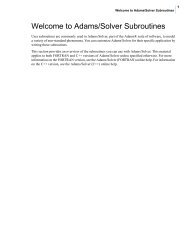You also want an ePaper? Increase the reach of your titles
YUMPU automatically turns print PDFs into web optimized ePapers that Google loves.
<strong>ICAM</strong> <strong>Virtual</strong> <strong>Machine</strong> ® Version 19.0 <strong>Virtual</strong> <strong>Machine</strong> Reference, Menu Bar<br />
Simulation»Construct Axis (Quest only)<br />
one of the major axes. When Custom is selected, you must enter a Custom rotation vector,<br />
which defines the X, Y and Z-axis vector components of the axis of rotation, using<br />
the “right hand rule”. Using your right hand, point your thumb in the direction of the vector;<br />
your fingers curl in the direction of positive rotation.<br />
� Use range validation: Clear this check box if the rotary axis has unlimited physical travel.<br />
� Spindle definition: Select the “This rotary axis connects to a spindle” check box if the<br />
rotary axis can double as a spindle. This is common for mill/turn lathes, where the spindle<br />
can freely rotate when turning but then be interpolated as a rotary axis when milling.<br />
VM uses the Spindle ID to differentiate between the different spindles that might be<br />
available on a machine. Once defined, a spindle can be later mapped as a milling or turning<br />
spindle using the Axes mapping tab page of the machine properties dialog. A Ratio<br />
can be specified if the spindle rotation is not 1:1.<br />
� Turret definition: Select the “This rotary axis is used as a turret” check box if the rotary<br />
axis defines the rotation of a lathe tool turret. VM uses the Turret number to differentiate<br />
between the different turrets that might be available on a machine. Turret number 1<br />
should be used for the main turret. Turret number 2 should be used for a second turret if<br />
one exists. The Positioning field is used by VM to position the turrets as tools are loaded.<br />
With Automatic positioning, the turret is expected to have the available tool slots equally<br />
distributed around the perimeter. Use Predefined positioning and select the Set positions<br />
button to define the turret rotation angle for each of the available tool slots.<br />
� Label offset: Defines the offset of the informational kinematics marker along the rotation<br />
axis. Kinematics markers can be enabled or disabled using the VM Grid tool bar.<br />
When defining a rotary axis with a Custom orientation, you can enter the custom rotation vector,<br />
or you can use a standard orientation and use the Rotate button to orient the axis. Both methods<br />
produce identical kinematics, but the Rotate method has the side effect of changing the XYZ<br />
reference coordinates for any objects attached to the axis.<br />
Simulation»Construct Axis»Curve Axis<br />
Creates a curved profile axis, given an XYZ origin and<br />
a profile curve. Curved axes can be used to interpolate<br />
along an opened or closed track. Parameters common to<br />
all axes (not listed below) can be found on page 96.<br />
� Profile button: Select this button to enter a 2D<br />
profile curve. The profile is defined as a series<br />
of (x, y) pairs of coordinates, one pair per line.<br />
Use the Apply button in the profile builder to see<br />
changes to the profile curve.<br />
� Translation only: When a curve axis moves, the<br />
objects that are attached to it can be moved<br />
through space as a simple translation, or they<br />
can be both translated and rotated to stay “normal”<br />
to the curve.<br />
98 <strong>ICAM</strong> Technologies Corporation – Proprietary















